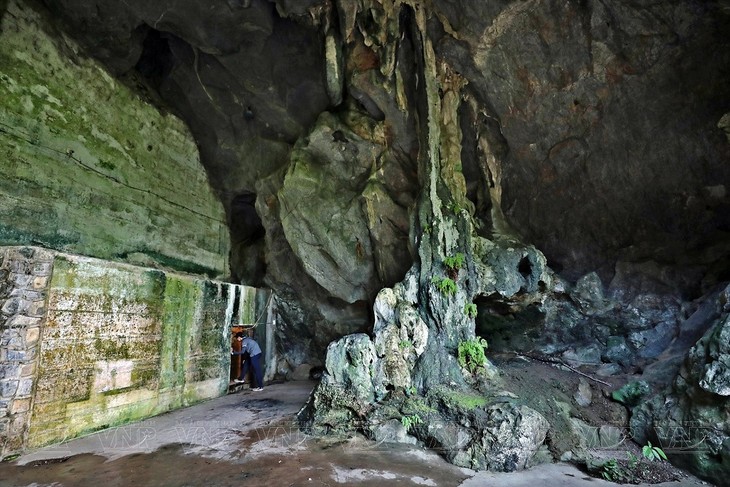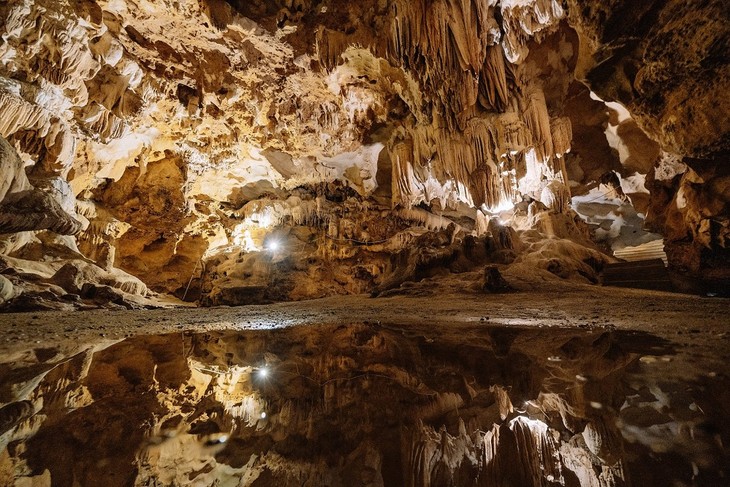(VOVWORLD) - Ha Long Bay-Cat Ba Archipelago has just been recognized as a world geological heritage by the International Union of Geological Sciences (IUGS) for its many rocky islands rising from the sea and, hiding inside them, mysterious caves that few other places have.
 Quan Y case in Cat Ba archipelago (hoto: VNA) Quan Y case in Cat Ba archipelago (hoto: VNA) |
Scientists estimate that there are about 150 caves scattered throughout the Cat Ba archipelago, but due to the rugged terrain of the islands, only 70 caves have been surveyed and named.
Some of the biggest caves are Hoa Cuong, Trung Trang, Quan Y, and Thien Long. Each name is associated with the cave’s geological features or history. Hoa Cuong (granite) cave has many stalactites which sparkle when illuminated. Thien Long (heaven dragon) cave is located in an area that looks like a dragon.
The caves in the Cat Ba archipelago are not as high as the limestone caves in the mountains of the mainland, but the infiltration of rainwater has formed stalactites that are equally beautiful.
Dinh Van Tung of the Center for Education and Environmental Services in Cat Ba National Park said: “The caves were formed in the most vulnerable areas of the limestone mountain system. There are two types of cave formation. The first is due to subsidence and erosion. The second is due to chemical impacts of corrosive reactions. Limestone is very susceptible to corrosion, so when raindrops seep down from the mountain tops, they erode, corrode, and dissolve the limestone. The water runs through grooves to create stalactites and stalagmites.”
 Hoa Cuong cave in Gia Luan district (Photo: haiphong.gov.vn) Hoa Cuong cave in Gia Luan district (Photo: haiphong.gov.vn) |
The animals that live in the caves on the Cat Ba islands have evolved traits different from animals of the same species living in other areas. Bats comprise the majority of the animals here. The bats that live in the Cat Ba caves belong to rare species that are only seen in this area, according to Nguyen Van Thiu, Director of Cat Ba National Park.
“Some species live in caves. In Trung Trang cave there are bats, reptiles, and frogs. Two endemic creatures are the Cat Ba Griffin's leaf-nosed bat and the Cat Ba leopard gecko,” said Thiu.
The caves in Cat Ba are divided into two groups: caves with one entrance and caves with multiple entrances. Hoa Cuong cave in Gia Luan commune and Thien Long cave in Phu Long commune both have a large entrance and a diverse system of stalactites.
Dinh Van Tung said: “The cause is the geological structure of the faults in the arc direction of the mountainside. For tectonic reasons, the arc direction can be on the right or left. The geological layer of sediment changes the structure of each arc. There’s a very large cave entrance.”
Trung Trang cave, Tien Duc cave, and Hung Son cave run clear through the mountain and each has two or three entrances. Along their 200 to 400 meter length are clusters of beautiful stalactites and stalagmites.
“The diverse colors depend on the rainwater seepage. An area with more water will have a more sparkling tectonic structure. Limestone and sedimentary rocks have heterogeneous structures and changes in geological layers. The erosion process washes away minerals, so the color of the stalactites is not uniform,” said Tung.
Trung Trang cave stands out for its beautiful stalactites. Quan Y cave has a spacious hall. Thien Long cave and Hoa Cuong cave preserve archaeological relics that prove the presence of ancient humans.